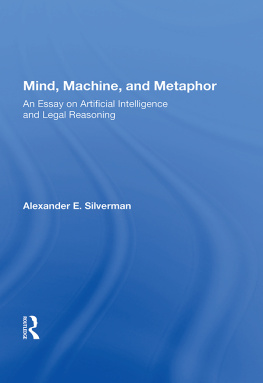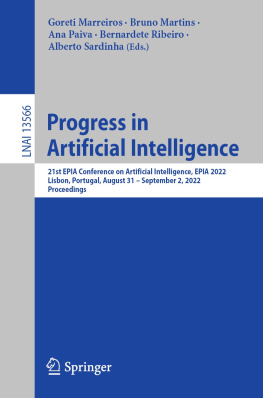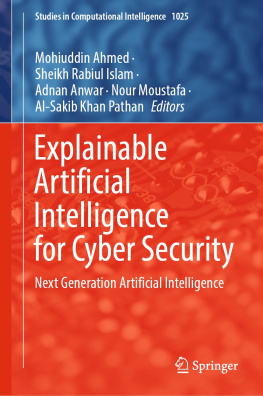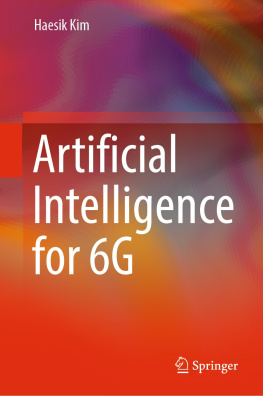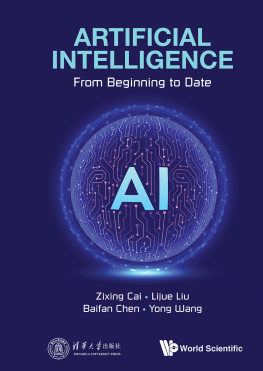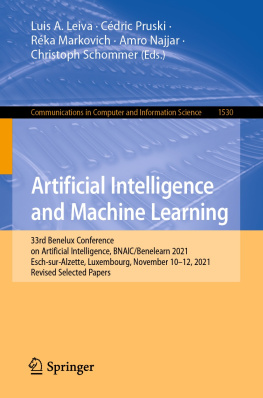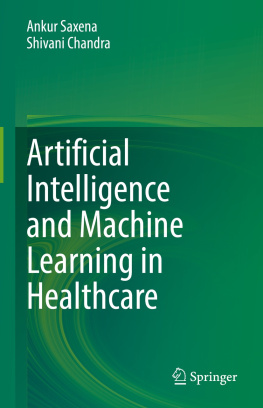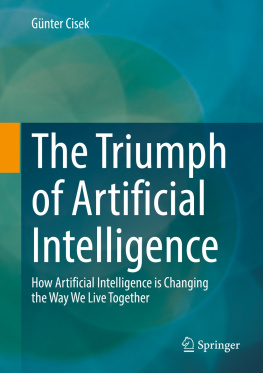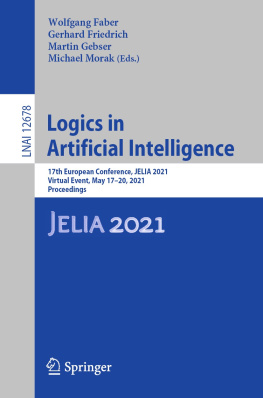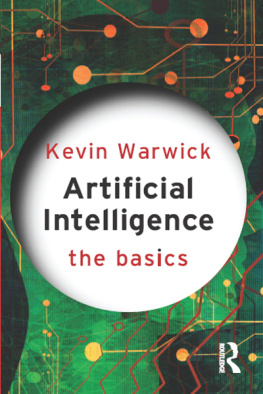Mind, Machine, and Metaphor
New Perspectives on Law, Culture, and Society
Robert W. Gordon and Margaret Jane Radin,
Series Editors
Mind, Machine, and Metaphor: An Essay on Artificial Intelligence and Legal Reasoning, Alexander E. Silverman
Rebellious Lawyering: One Chicanos Vision of Progressive Law Practice, Gerald P. Lpez
Wittgenstein and Legal Theory, edited by Dennis M. Patterson
Pragmatism in Law and Society, edited by Michael Brint and William Weaver
Feminist Legal Theory: Readings in Law and Gender, edited by Katharine T. Bartlett and Rosanne Kennedy
FORTHCOMING
Words That Wound: Critical Race Theory; Assaultive Speech, and the First Amendment, Mari J. Matsuda, Charles R. Lawrence III, Richard Delgado, and Kimberl Williams Crenshaw
Intellect and Craft: Writings of Justice Hans Linde, edited by Robert F. Nagel
Property and Persuasion: Normativity and Change in the Jurisprudence of Property, Carol M. Rose
Failed Revolutions: Why Good Intentions, Great Promise, and Boundless Energy Fail to Transform the World, Richard Delgado and Jean Stefancic
The Philosophy of International Law: A Human Rights Approach, Fernando R. Tesn
In Whose Name? Feminist Legal Theory and the Experience of Women, Christine A. Littleton
First published 1993 by Westview Press
Published 2018 by Routledge
52 Vanderbilt Avenue, New York, NY 10017
2 Park Square, Milton Park, Abingdon, Oxon OX14 4RN
Routledge is an imprint of the Taylor & Francis Group, an informa business
Copyright 1993 by Alexander E. Silverman
All rights reserved. No part of this book may be reprinted or reproduced or utilised in any form or by any electronic, mechanical, or other means, now known or hereafter invented, including photocopying and recording, or in any information storage or retrieval system, without permission in writing from the publishers.
Notice:
Product or corporate names may be trademarks or registered trademarks, and are used only for identification and explanation without intent to infringe.
A CIP catalog record for this book is available from the Library of Congress.
ISBN 0-8133-8575-X
ISBN 13: 978-0-367-00821-5 (hbk)
To Jared, for asking why the birds fly south
The word essay in this books subtitle was chosen deliberately. The book raises many questions that it does not answer and treats in a preliminary or speculative fashion subject areas that might be explored further in a longer work. Several readers of early drafts offered excellent suggestions for ways that the book could be expanded in scope and depth. However, in view of the time that would be required to respond fully to these suggestions, and the rapidity with which artificial intelligence technology is changing, it seemed best to publish the book in its current form. I hope that readers will find the ideas presented here to be helpful, fun, and worth pursuing.
I am indebted to Ruth Adams, Jay Atlas, Mark Berlin, Patrick Castelaz, David Chapman, Tom Grey, J. B. Kennedy, Derek Koehler, George Lakoff, Mari Matsuda, Helen Nissenbaum, Richard Perry, David Rosenhan, David Rumelhart, Paul Thagard, Robert Weisberg, and Steven Winter for their support, encouragement, and valuable insights. I was introduced to the idea of connectionist networks as function construction machines in a lecture by Thomas Caudell in Caudels course Introduction to Artificial Neural Systems, taught at UCLA Extension, Spring 1988. Thanks to Laura Yedwab for the streetlight example in and who listened for hours to my half-formed ideas as they were taking shape. This book would not have been completed without the help of Spencer Carr and Shena Redmond, my editors at Westview, and Rene Glover, who provided me with access to a laser printer when I most needed one.
Thanks most of all to Susie Skadron, for faithful love and patience.
Alexander E. Silverman
People write about artificial intelligence (AI) and law from any of several viewpoints. They may write as computer scientists, describing the development and implementation of a legal expert system or similar computer program, often in considerable technical detail. They may write as practicing attorneys, discussing the application of particular computer programs or systems in actual law practice. They may write as commentators on legal doctrine relating to AI, especially intellectual property law. Finally, they may write as legal theorists, speculating on the jurisprudential implications of AI.
This essay takes the legal theorists viewpoint. Attempts to apply so-called classical AI approaches to legal problem solving have met with limited success. Classical AI approaches embody brittle models of law and of human reasoning, and the limitations of these approaches are in essence the limitations of their models. Legal theorists and jurists often subscribe to the same sorts of models and encounter the same sorts of problems. New directions in AI research solve some of the problems of the classical approaches while raising new issues of their own. These new directions can illuminate new directions for jurisprudence as well.
The essays organization is as follows: new metaphors of law are developed, the most important being that of law as connectionist AI system embodied in society. The entailments of the metaphors are considered; in particular, legal rules are seen as best-fit approximations to the law. In Chapter 61 focus on what the Al-law analogy suggests about human legal reasoning. The notion of the rule of law as something other than the law of rules is suggested, and the relationship between judicial opinion writing and human explanation capability is considered.
This essay takes seriously the notion that metaphor, rather than being mere trope, is essential to human thought and language, and in particular to the process of jurisprudential theory-building. Changes in theory are linked to changes in conceptual or metaphorical framework. In developing new metaphors of law, this essay does not purport to describe what law is. Rather, it illustrates how law may be seen in new and potentially useful ways.
Thomas Grey writes that theory is good for getting us out of trouble as we attempt to solve problems. He goes on to note that theory can also be a medium of playdeep play, but play nonetheless. It may well be that this or any jurisprudential essay is no more (or less) than a game. On the other hand, sometimes playing a game can be therapeutic.
There is such a thing [as human nature], and it is not entirely tractable.
Melvin Konner, The Tangled Wing (1982)
Approaches to AI
Roughly speaking, AI is the attempt by computer scientists to model or simulate intelligent behavior on computers. An overview of the field is beyond the scope of this essay, but it is helpful to review some concepts that will be important later on. The classical and connectionist approaches, which compose the mainstream of AI research, are discussed in this section, along with the newer fuzzy approaches. (The more radical interactionist approaches are taken up in the last section of the chapter.)
Classical and Connectionist Approaches
AI researchers have adopted two main sets, or families, of approaches, the classical and the connectionist approaches. Classical approaches include rule-based expert systems, frame systems, blackboard systems, logic programming, and various other related approaches. They served as the basis of the vast majority of AI research from the early 1960s through the mid-1980s and continue to serve as the basis for most AI research today. Connectionist approaches, also called parallel distributed processing or artificial neural network approaches, attempt to model or to pattern themselves after the processing mechanisms of human and animal brains. Examples include backpropagation networks, Hopfield networks, and adaptive resonance models. Connectionist approaches were first tried as early as the 1940s but nearly died out in the late 1960s. They have enjoyed a resurgence within the past decade and, according to their proponents, have provided useful methods for solving certain problems that had been difficult or intractable under classical approaches.

